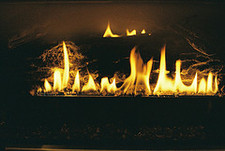
by blogediter | Apr 24, 2019 | Gas Logs
Q: Jason, I have a set of vent free gas logs in my fireplace. The fireplace also has a regular 18″ round chimney flue and a round metal flapper damper. If I understand correctly most vent free gas logs do not have a chimney since they are supposed to vent into the house directly to provide all the heat to the living area.
The damper on this ventless gas log fireplace chimney is worn out and lets in noise and cold air when the fireplace is not being used. Can I install a Chimney Balloon above the damper and close the damper and keep the Chimney Balloon in place even during the time I use this ventless gas log fireplace? – KK
A: Dear KK, We get a lot of questions about using a Chimney Balloon with gas log fireplaces. Especially about ventless gas log fireplaces that have chimneys. Most vent less (or vent free) gas log fireplaces do not have chimneys or flues in the first place. They are often designed to vent directly into the living area. This does allow them to give all of their heat to the living area, but it also allows them to give all of their fumes and moisture to the living area as well. For this reason I am not too keen on vent free gas logs.
To get to your question about the Chimney Balloon and if you can use it above your damper on this vent free gas log. You said your damper is leaking in cold air and noise from the outside and the damper is not in good shape. This means the leak goes both ways on your damper. Cold is coming in and heat certainly going out both during your fireplace use and when the fireplace is dormant. The Chimney Balloon is designed to shrivel and release when heat or fire is introduced to it. This release mechanism triggers at about 180 to 220 degrees. The Chimney Balloon does this because it is designed to plug the chimney flue, and in most cases it is not desirable to have a plugged chimney flue when you have a fire in your fireplace.
So if you light a fire in your ventless fireplace and the Chimney Balloon is installed above your damper (even with the damper closed) the damper itself will heat up and conduct heat through. As you said, the damper is also leaky since it allows cold air down, it will also allow heat up as well. That heat will come in contact with the Chimney Balloon. This will certainly trigger the release of the Chimney Balloon sooner or later (probably sooner). Then you will have a cooked Chimney Balloon. It is still worth it to have the Chimney Balloon in place in your fireplace when you are not using this vent free fireplace since it will eliminate the cold air and noise issue, but you cant leave it in place during use of your fireplace.
I have had many people ask: “what is safe to use above a ventless gas log to plug the flue?” Some people use safing insulation to plug the fireplace flue above a ventless gas log. I realize safing insulation is fire retardant, but safing insulation is not made for this specific purpose so this is a risky venture at best. – Jason
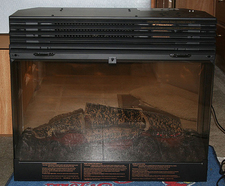
by blogediter | Dec 12, 2018 | Chimney Plugs
Electric Fireplace
Q: Jason – I installed one of those cool electric hologram type fireplace inserts into my wood burning fireplace. I have a cold draft that is coming down the chimney and it seeps out around the electric fireplace box insert.
I was told by the installer that he stuffed the flue full of fiberglass batting, but if I still have a draft. He told me I should remove the fiberglass and put in a Chimney Balloon. Can I install a Chimney Balloon and then put my electric fireplace insert back in place? – PR
A: Dear PR, Fiberglass is a rotten air barrier if you have a location that has air movement (like a Chimney). A Chimney Balloon will work just fine above your electric fireplace insert. Before you install the insert, be sure to install your Chimney Balloon high enough into the fireplace flue so it does not come in contact with the insert. Also, remember to remove the inflation tube after inflating the Chimney Ballon in place so it doesn’t hang down in the way. Wait 24 hours after you install the Chimney Balloon and check the Chimney Balloon again. This will ensure you installed it properly and solidly and it is working properly before you slide in the electric fireplace insert. Then take a peek at the Chimney Balloon every year or two just to top it off with air if needed.
Most of these electric inserts are closed systems so they put no heat up the flue at all (see the image above that the top is flat and it is fully encased), If you unit is encased, you just want to make sure the heating element and fan will not come in contact with the Chimney Balloon.
We have had many customers buy a Chimney Balloon for this type of electric fireplaces application. I have a family member with an electric fireplace that was installed as an insert in his old wood fireplace. I helped him put a Chimney Balloon in his flue as well for the same reasons you are stating. I think electric fireplaces are great and add a nice ambiance, but have no venting issues. – Jason
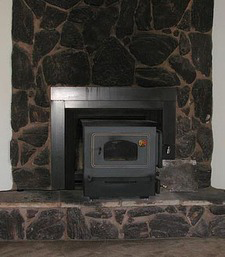
by blogediter | Nov 12, 2018 | Chimney Plugs
Bad Insert
Q: Jason – The wife is interested in getting a wood burning insert for the fireplace. We’re regular users of our fireplace and keep a supply of inexpensive hardwoods around. With upcoming increases in electricity costs around here, we thought it was about time that we sunk the $4-5K into a wood burning insert.
A: DW – Since your goal is to save money on heat and you mention your concern about electrical prices…I have to assume your home is now heated by electrical heat. Is that correct?
Well, if your goal is to save heat and therefore save money I would probably point you in an entirely different direction. First of all, stop using the fireplace for heat. Due to the stack effect in your home and the draw of combustion and rising air from the fire you are losing more heat than you are creating. Fireplaces are notoriously inefficient. The Department of Energy estimates using a fireplace raises your heat energy costs by 10% on average. The best thing you can do is plug the flue with a Chimney Balloon and look for other options.
Your other installed option, electric heat, is the second most inefficient type of standard heating. So I would also steer you from using that.
You could go with a fireplace insert and have the hassle of consuming wood, the maintenance of maintaining a clean flue and chimney, the constant feeding of the fire and the increased home insurance rates. With this option, you can get an average 60% efficiency for your labors. See below for a picture of a bad hack job of a fireplace insert install that leaks smoke. This picture is not my house, By the way.
Or, you could go a more traditional route by applying your money to a direct vent gas furnace and ducting that will give you a 90% efficiency. Granted this may cost you more since ductwork has to be laid, but it will be less laborious and costly than any other option in the long run. You won’t need a chimney either since it can be vented easily through the side of the house in a minimally invasive way.
I considered the very question you were pondering about 4 years ago when I had an aged furnace and an open fireplace. I decided to plug the fireplace tightly with a Chimney Balloon to stop the heat loss through the bad damper and flue and upgrade the furnace to a direct vent 90% efficient. I have been so happy with this decision, and I would do the exact same thing again if I had the choice. I hope you find this input/testimony helpful – Jason
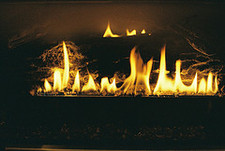
by blogediter | Sep 21, 2018 | Gas Logs
Gas Burn
Q: Jason, I have a wood fireplace right now but no supply of wood. I am thinking of converting to a gas log fireplace to supplement my home heat. What do you think? -CM
A: CM, I have my opinions on this but this story from a customer speaks so well on the subject I will share that with you instead:
“…If you live in a cold climate area I wouldn’t really recommend you do anything with a wood burning fireplace, but plug up the chimney and maybe put a few candles in it. Why?… because I learned the hard way that fireplaces and gas logs are excellent ways to suck money right out of your pocket.
A few years ago I thought I would supplement my heat by burning wood in my fireplace. Turns out my heating bill went up because the fireplace was sucking the air out of my house when I burned. So I converted to a gas log fireplace (which it sounds to me like you have a partial gas log setup right now that needs fixing.) Well, part of having a gas log installed to code is to disable the damper or clip it open. This was even worse! I was constantly losing heat and the living room was drafty.
I ended up plugging the chimney with a Chimney Balloon to stop the cold draft from coming down the fireplace flue. This was allowable under code since the Chimney Balloon would melt and fall out if I accidentally light a fire under it. You see, this stupid “disable the damper building code” is only there so people don’t light a gas log and leave the damper closed on accident and therefore asphyxiate everyone in the house or set the place ablaze.
OK, long story short…I ran up my heat bill and spent $500 on a professionally installed gas log only to end up with a fireplace I don’t use because it wasted too much heat. So I put candles in it and plugged it with a Chimney Balloon.” – Terry B
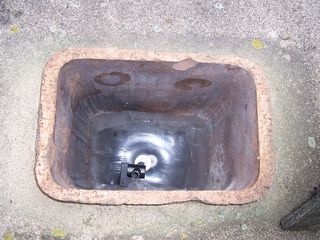
by blogediter | Aug 31, 2018 | Gas Logs
Plug My Vent Free Gas Log Chimney
Q: Jason, I have a set of non-vented gas logs which when not in use lets a horrible downflow of cold air in from outside. I saw an old thread that said the Chimney Balloon will deflate when installing near the damper if it is exposed to heat.
My question is can I close off the top of the chimney chase up on the roof with one of the Chimney Balloons? And would the temperature at that height be cool enough where we could fire the gas logs and still keep the Chimney Balloon intact? Thanks, DV
A: Hi DV, You pose a very good question. We have had many customers install a Chimney Balloon upside down from the top of the chimney when they have installed an electric fireplace insert, or if they have decommissioned their fireplace completely, but I have strong reservations about trying it with a vent free gas log.
My initial reaction is with the vent free gas log burning I am certain that the temperature at the top of the chimney will get to the 200 degrees Fahrenheit and trigger the Chimney Balloon to melt, shrink, and release. The reason for my certainty is that the damper you have is inevitably going to leak heat or convect heat into the chimney and that heat will naturally rise and collect against the Chimney Balloon.
My suggestion is to use the Chimney Balloon conventionally and just install it while the fireplace is not being used. Any amount of time you have the Chimney Balloon installed will be saving you money.
There is one other thing you should be aware of with your vent free gas log. There was a University of IL 3 year study that was done on ventless gas units in homes in Illinois. Here is a link to a blog article about the study and a link to the study results: http://www.chimneyballoonusa.com/blog/2009/08/3-year-univ-of-il-study-results-answer-how-safe-are-ventless-gas-logs.html
Personally, I found this research to be eye-opening and something that ventless gas log users should be aware of. I will let you draw your own conclusion from it, but pay particular attention to the NO2 level results in the study.- Jason




